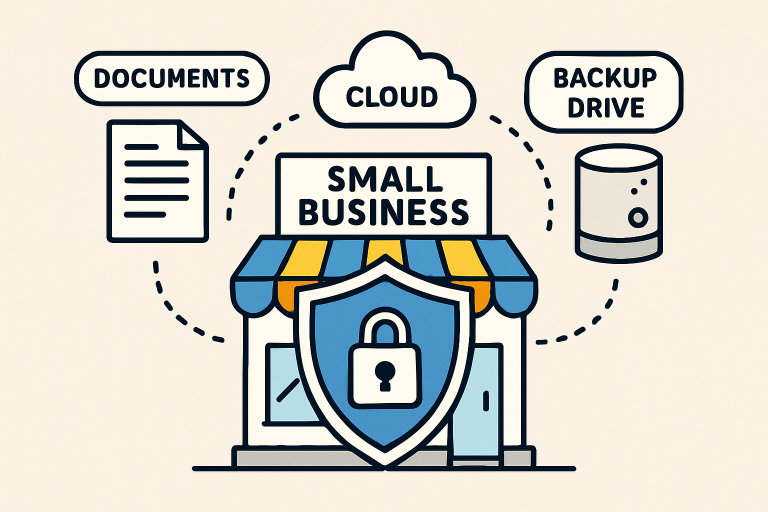The digital age has made information central to small business operations. Whether tracking inventory, processing payroll, managing customer relationships, or running online marketing campaigns, the data generated and stored by businesses serves as a vital lifeblood. Today, customer data, financial records, and sensitive business communications now live on servers and in the cloud—putting them at risk from a range of threats. Cybercrime continues to surge, with small and mid-sized businesses accounting for nearly 43% of ransomware victims. These attacks, which often result in inaccessible data and sky-high ransom demands, can hit smaller organizations the hardest as their resources are often limited. In addition to sophisticated ransomware, threats such as hardware malfunctions, natural disasters (including storms or fires), accidental file deletions, and everyday human mistakes illustrate why every business must have a backup and DR platform in place to mitigate potential catastrophes. Losing even a small part of your digital assets can have a significant impact on operations and customer trust.
Unlike large enterprises that have extensive IT departments and substantial financial reserves, smaller organizations often lack the resources to recover quickly from a data disaster. Therefore, proactive planning, clear protocols, and reliable tools become not just a best practice but a critical lifeline for survival. Even minor incidents, such as accidental file deletion or software updates gone awry, can halt business operations by making crucial information temporarily or permanently unavailable. Loss of key files can delay projects, disrupt services, and compromise customer satisfaction.
Research from the FBI and cybersecurity agencies highlights the growing sophistication of cyberattacks, indicating that even the most diligent businesses are only ever one vulnerability away from significant data loss. With attackers often exploiting unsuspected weaknesses or human error, it’s not just high-profile breaches that cause concern—routine mishaps are equally damaging. The risk landscape is ever-evolving, and without strong digital safeguards, even well-run companies risk significant loss—even closure.
The fear of data loss is not just about direct threats, but also the domino effect: When systems go down, productivity halts, customers are left waiting, and every minute counts against the bottom line. An inability to access data at the right time can set back weeks or months of progress, putting business relationships and contracts at risk.
The Financial Implications of Downtime
Data loss is not merely an IT problem—it’s a bottom-line issue with potentially disastrous effects on profitability. On average, incidents of downtime cost businesses approximately $84,650 per hour, with recovery often requiring extensive labor and resources. For a small business, even brief outages can result in weeks of lost revenue, missed contract deadlines, and costly recovery measures. These costs are not always obvious, as they may include lost client confidence or punitive fees for failing to meet contractual obligations. According to the U.S. Small Business Administration, a significant number of small businesses are unable to reopen after a major data disaster—highlighting the stakes at hand. Additionally, businesses may find themselves needing to pay for emergency IT services, hastily procure replacement equipment, or notify customers and partners about security incidents, all of which can further escalate expenses. As disruptions persist, the cumulative impact on finances can become overwhelming.
Protecting Business Reputation
Customer trust is earned over time but can be lost in an instant after a data breach or major data loss event. A startling 81% of consumers report disengaging from companies after a significant data security failure, and in crowded industries, those customers are unlikely to return. The resulting brand damage from just one breach—let alone repeated failures—can have a lasting impact on customer loyalty and future business prospects. To rebuild after such losses is often costly, time-consuming, and, in some cases, futile. Besides consumer backlash, negative media coverage, and poor online reviews can haunt a business for years. Social media and business rating sites can amplify every incident, making reputation recovery even more difficult. In many situations, apologizing and making amends may not be sufficient to reverse the distrust or negative publicity that has been incurred.
Ensuring Compliance with Regulations
Businesses operating in sectors like healthcare, finance, or retail cannot afford to ignore regulatory compliance. Laws such as HIPAA for healthcare and PCI DSS for payment processing impose stringent data protection requirements, which govern how data is stored, encrypted, and retrieved. Non-compliance can lead to hefty fines, lawsuits, and even business closure if sensitive client or patient information is mishandled or lost. Maintaining a backup and recovery plan tailored to meet industry regulations is crucial not only for protecting data but also for reducing legal exposure. Regulatory agencies are becoming increasingly vigilant about enforcement—underscoring the importance of ongoing compliance. In some cases, regular audits and proof of a working backup system are required for continued operation, making sound data governance not just a suggestion but a business necessity.
Implementing a Robust Backup and Recovery Plan
Establishing an effective backup strategy requires more than periodic file copying; it should include key components such as regular automated backups to reduce the potential for data loss, off-site storage to protect against physical disasters, employee training on safe data practices to mitigate security breaches, and disaster recovery testing to ensure operational efficiency during emergencies. Additionally, businesses must regularly review and update their backup strategies to keep pace with technological advancements and new regulatory requirements.
Leveraging Cloud Backup Solutions
The shift to cloud-based backup solutions has leveled the playing field for small businesses, providing enterprise-level security and reliability at affordable prices. Cloud platforms offer automated scheduling, end-to-end encryption, rapid scalability, and remote access from virtually anywhere, offering convenience and peace of mind that traditional methods usually cannot match. These solutions protect against local disasters, cyberattacks, and user error, and ensure that the latest version of your data is always secure and retrievable. Several providers, including large-scale platforms such as Microsoft Azure and Google Cloud, offer robust solutions tailored to meet the needs of small businesses. The ability to restore operations within minutes—even after a major hardware failure or breach—can make the difference between survival and shutdown. Furthermore, the pay-as-you-go models of many cloud services mean small businesses can scale their backup needs without incurring prohibitive upfront costs or investing in significant hardware updates every few years.
Conclusion
A resilient backup and recovery plan is fundamental for small business success in the digital economy. It shields organizations from data loss, legal liability, financial ruin, and customer distrust. With ongoing risks and regulatory demands, small businesses must prioritize smart strategies—investing in cloud technology, regular testing, and staff training to safeguard what matters most: their future and their reputation. Failing to put these systems in place isn’t an option if security, continuity, and competitive advantage are key priorities for your business growth.










